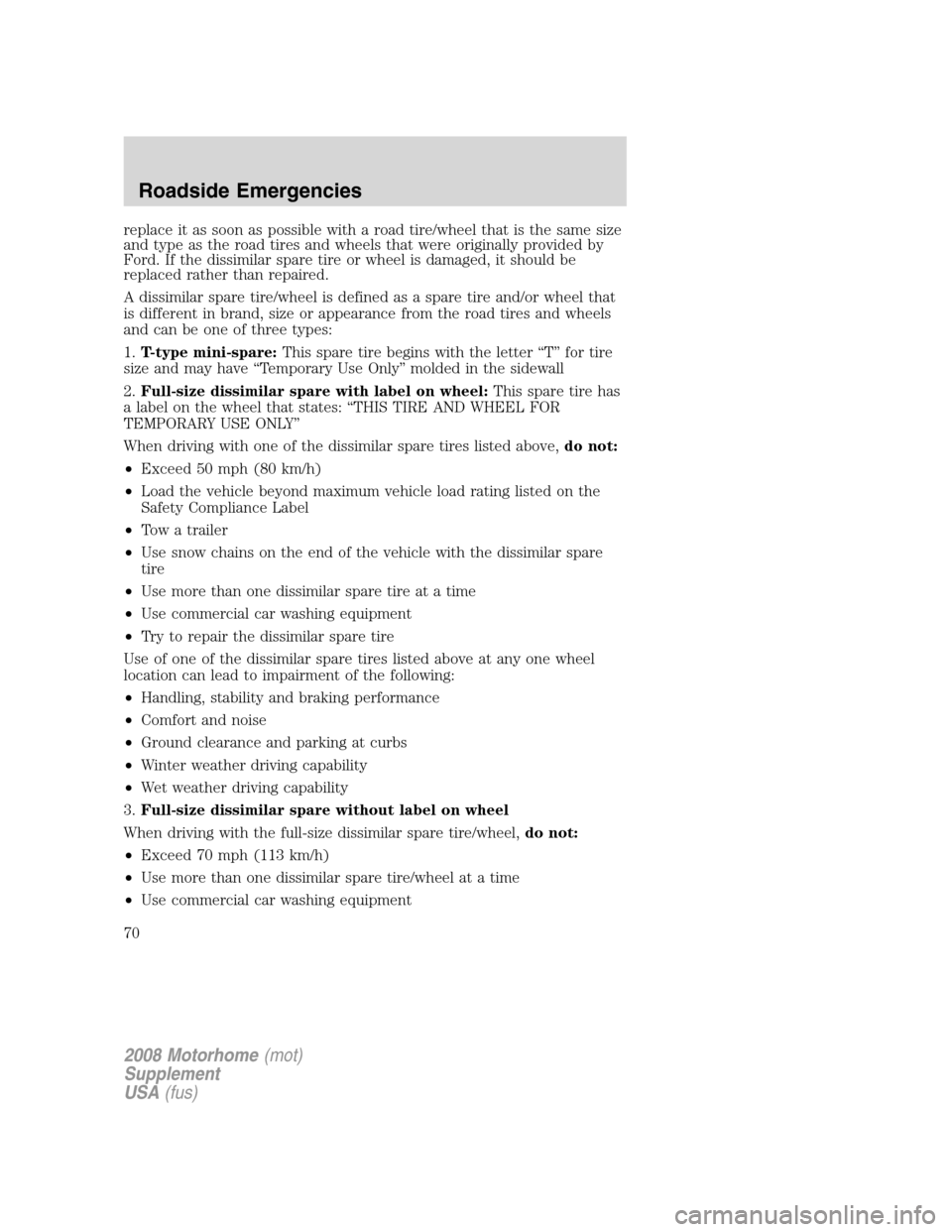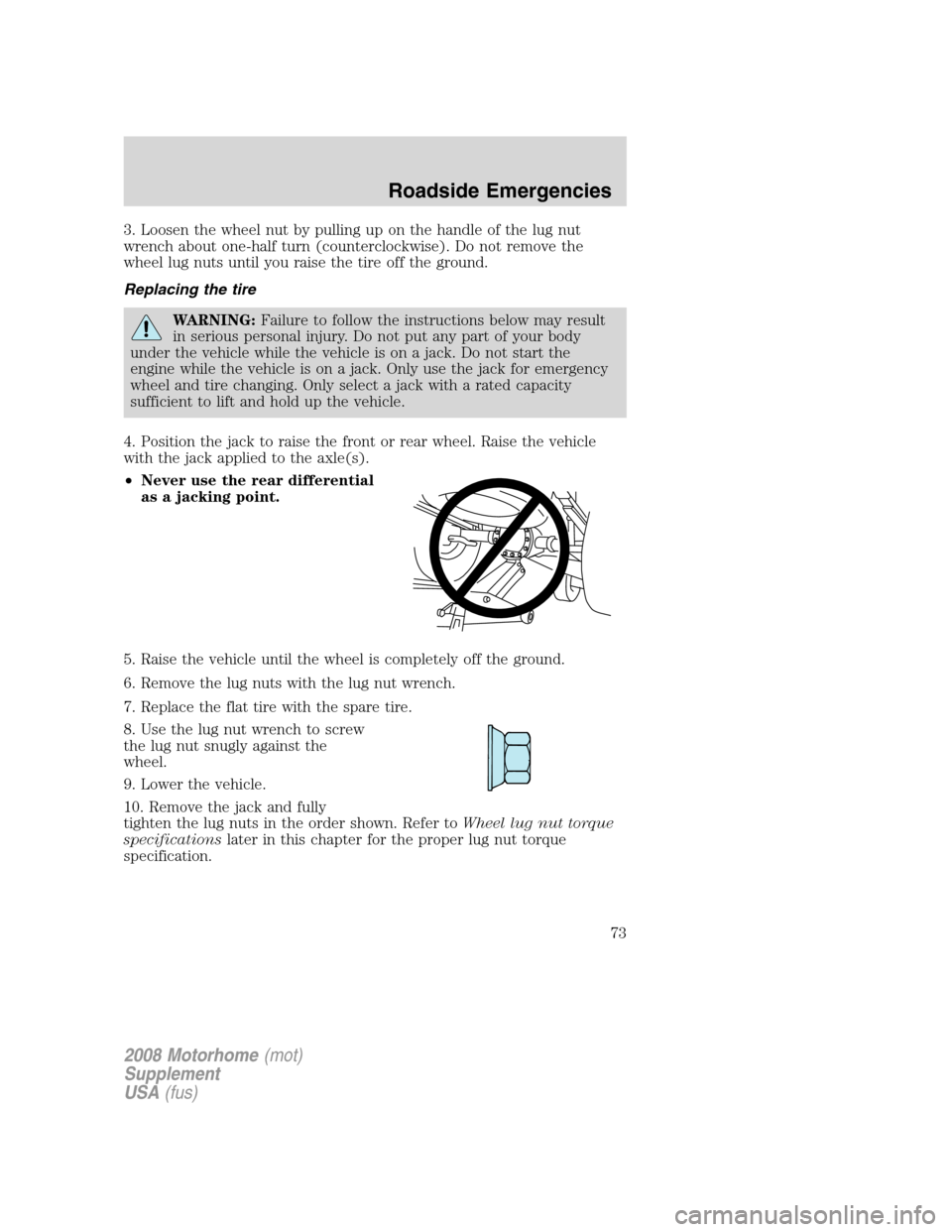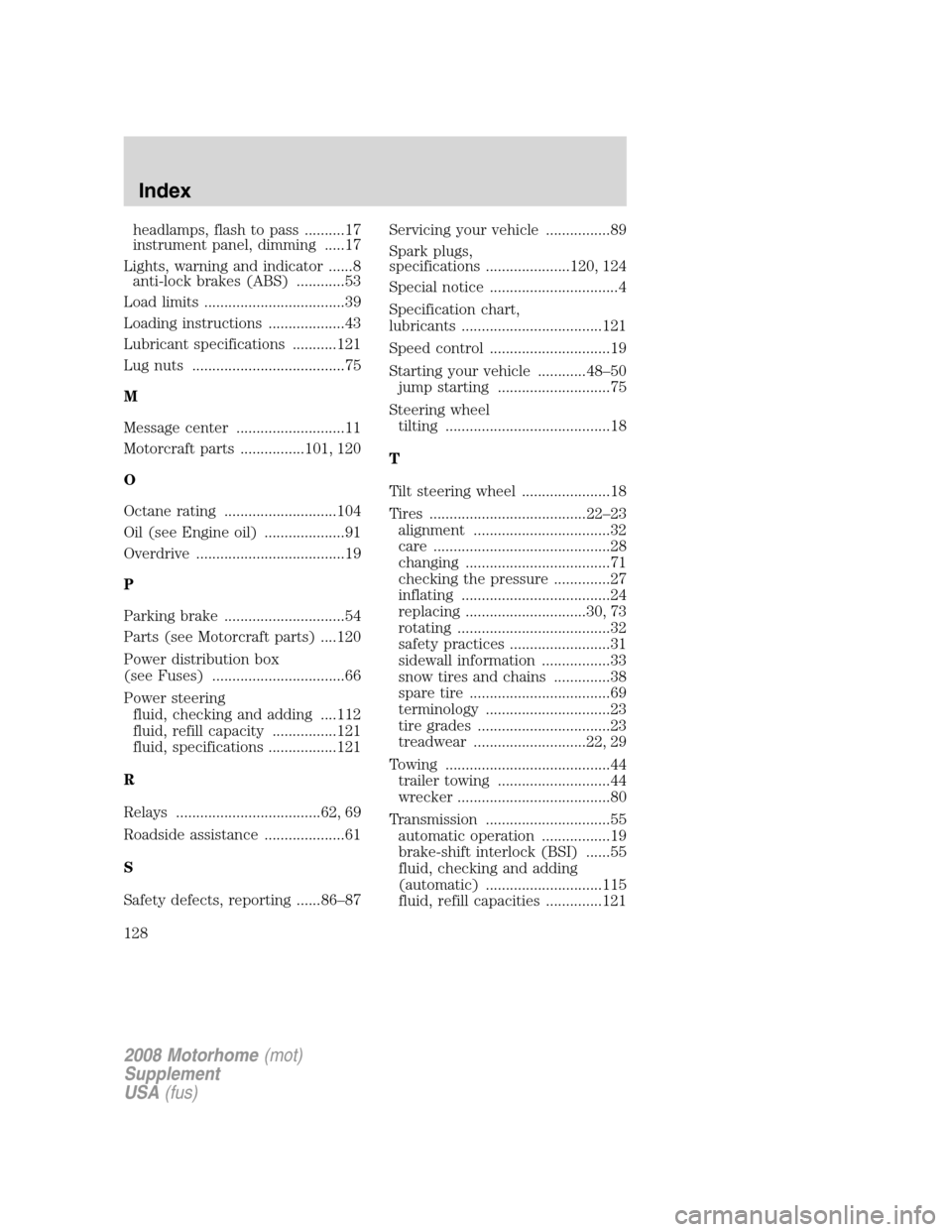Page 70 of 130

replace it as soon as possible with a road tire/wheel that is the same size
and type as the road tires and wheels that were originally provided by
Ford. If the dissimilar spare tire or wheel is damaged, it should be
replaced rather than repaired.
A dissimilar spare tire/wheel is defined as a spare tire and/or wheel that
is different in brand, size or appearance from the road tires and wheels
and can be one of three types:
1.T-type mini-spare:This spare tire begins with the letter “T” for tire
size and may have “Temporary Use Only” molded in the sidewall
2.Full-size dissimilar spare with label on wheel:This spare tire has
a label on the wheel that states: “THIS TIRE AND WHEEL FOR
TEMPORARY USE ONLY”
When driving with one of the dissimilar spare tires listed above,do not:
•Exceed 50 mph (80 km/h)
•Load the vehicle beyond maximum vehicle load rating listed on the
Safety Compliance Label
•Tow a trailer
•Use snow chains on the end of the vehicle with the dissimilar spare
tire
•Use more than one dissimilar spare tire at a time
•Use commercial car washing equipment
•Try to repair the dissimilar spare tire
Use of one of the dissimilar spare tires listed above at any one wheel
location can lead to impairment of the following:
•Handling, stability and braking performance
•Comfort and noise
•Ground clearance and parking at curbs
•Winter weather driving capability
•Wet weather driving capability
3.Full-size dissimilar spare without label on wheel
When driving with the full-size dissimilar spare tire/wheel,do not:
•Exceed 70 mph (113 km/h)
•Use more than one dissimilar spare tire/wheel at a time
•Use commercial car washing equipment
2008 Motorhome(mot)
Supplement
USA(fus)
Roadside Emergencies
70
Page 71 of 130
•Use snow chains on the end of the vehicle with the dissimilar spare
tire/wheel
The usage of a full-size dissimilar spare tire/wheel can lead to
impairment of the following:
•Handling, stability and braking performance
•Comfort and noise
•Ground clearance and parking at curbs
•Winter weather driving capability
•Wet weather driving capability
•All-Wheel driving capability (if applicable)
•Load leveling adjustment (if applicable)
When driving with the full-size dissimilar spare tire/wheel additional
caution should be given to:
•Towing a trailer
•Driving vehicles equipped with a camper body
•Driving vehicles with a load on the cargo rack
Drive cautiously when using a full-size dissimilar spare tire/wheel and
seek service as soon as possible.
Stopping and securing the vehicle
1. Park on a level surface.
2. Activate the warning flashers.
3. Place the gearshift in P (Park).
2008 Motorhome(mot)
Supplement
USA(fus)
Roadside Emergencies
71
Page 72 of 130

4. Apply the parking brake and turn
engine OFF.
Tire change procedure
WARNING:To help prevent the vehicle from moving when you
change a tire, be sure the parking brake is set, then block (in
both directions) the wheel that is diagonally opposite (other side and
end of the vehicle) to the tire being changed.
WARNING:Do not attempt to change a tire on the side of the
vehicle close to moving traffic. Pull far enough off the road to
avoid the danger of being hit when operating the jack or changing the
wheel.
1. Block the wheel that is diagonally
opposite the tire you are changing.
The parking brake is on the
transmission. Therefore, the vehicle
will not be prevented from moving
when a rear wheel is lifted, even if
the parking brake is applied. Be sure to block both directions of the
wheel that is diagonally opposite to the wheel that is being lifted.
WARNING:If the vehicle slips off the jack, you or someone else
could be seriously injured.
2. Remove the spare tire and jack from the storage location.
2008 Motorhome(mot)
Supplement
USA(fus)
Roadside Emergencies
72
Page 73 of 130

3. Loosen the wheel nut by pulling up on the handle of the lug nut
wrench about one-half turn (counterclockwise). Do not remove the
wheel lug nuts until you raise the tire off the ground.
Replacing the tire
WARNING:Failure to follow the instructions below may result
in serious personal injury. Do not put any part of your body
under the vehicle while the vehicle is on a jack. Do not start the
engine while the vehicle is on a jack. Only use the jack for emergency
wheel and tire changing. Only select a jack with a rated capacity
sufficient to lift and hold up the vehicle.
4. Position the jack to raise the front or rear wheel. Raise the vehicle
with the jack applied to the axle(s).
•Never use the rear differential
as a jacking point.
5. Raise the vehicle until the wheel is completely off the ground.
6. Remove the lug nuts with the lug nut wrench.
7. Replace the flat tire with the spare tire.
8. Use the lug nut wrench to screw
the lug nut snugly against the
wheel.
9. Lower the vehicle.
10. Remove the jack and fully
tighten the lug nuts in the order shown. Refer toWheel lug nut torque
specificationslater in this chapter for the proper lug nut torque
specification.
2008 Motorhome(mot)
Supplement
USA(fus)
Roadside Emergencies
73
Page 128 of 130

headlamps, flash to pass ..........17
instrument panel, dimming .....17
Lights, warning and indicator ......8
anti-lock brakes (ABS) ............53
Load limits ...................................39
Loading instructions ...................43
Lubricant specifications ...........121
Lug nuts ......................................75
M
Message center ...........................11
Motorcraft parts ................101, 120
O
Octane rating ............................104
Oil (see Engine oil) ....................91
Overdrive .....................................19
P
Parking brake ..............................54
Parts (see Motorcraft parts) ....120
Power distribution box
(see Fuses) .................................66
Power steering
fluid, checking and adding ....112
fluid, refill capacity ................121
fluid, specifications .................121
R
Relays ....................................62, 69
Roadside assistance ....................61
S
Safety defects, reporting ......86–87Servicing your vehicle ................89
Spark plugs,
specifications .....................120, 124
Special notice ................................4
Specification chart,
lubricants ...................................121
Speed control ..............................19
Starting your vehicle ............48–50
jump starting ............................75
Steering wheel
tilting .........................................18
T
Tilt steering wheel ......................18
Tires .......................................22–23
alignment ..................................32
care ............................................28
changing ....................................71
checking the pressure ..............27
inflating .....................................24
replacing ..............................30, 73
rotating ......................................32
safety practices .........................31
sidewall information .................33
snow tires and chains ..............38
spare tire ...................................69
terminology ...............................23
tire grades .................................23
treadwear ............................22, 29
Towing .........................................44
trailer towing ............................44
wrecker ......................................80
Transmission ...............................55
automatic operation .................19
brake-shift interlock (BSI) ......55
fluid, checking and adding
(automatic) .............................115
fluid, refill capacities ..............121
2008 Motorhome(mot)
Supplement
USA(fus)
Index
128